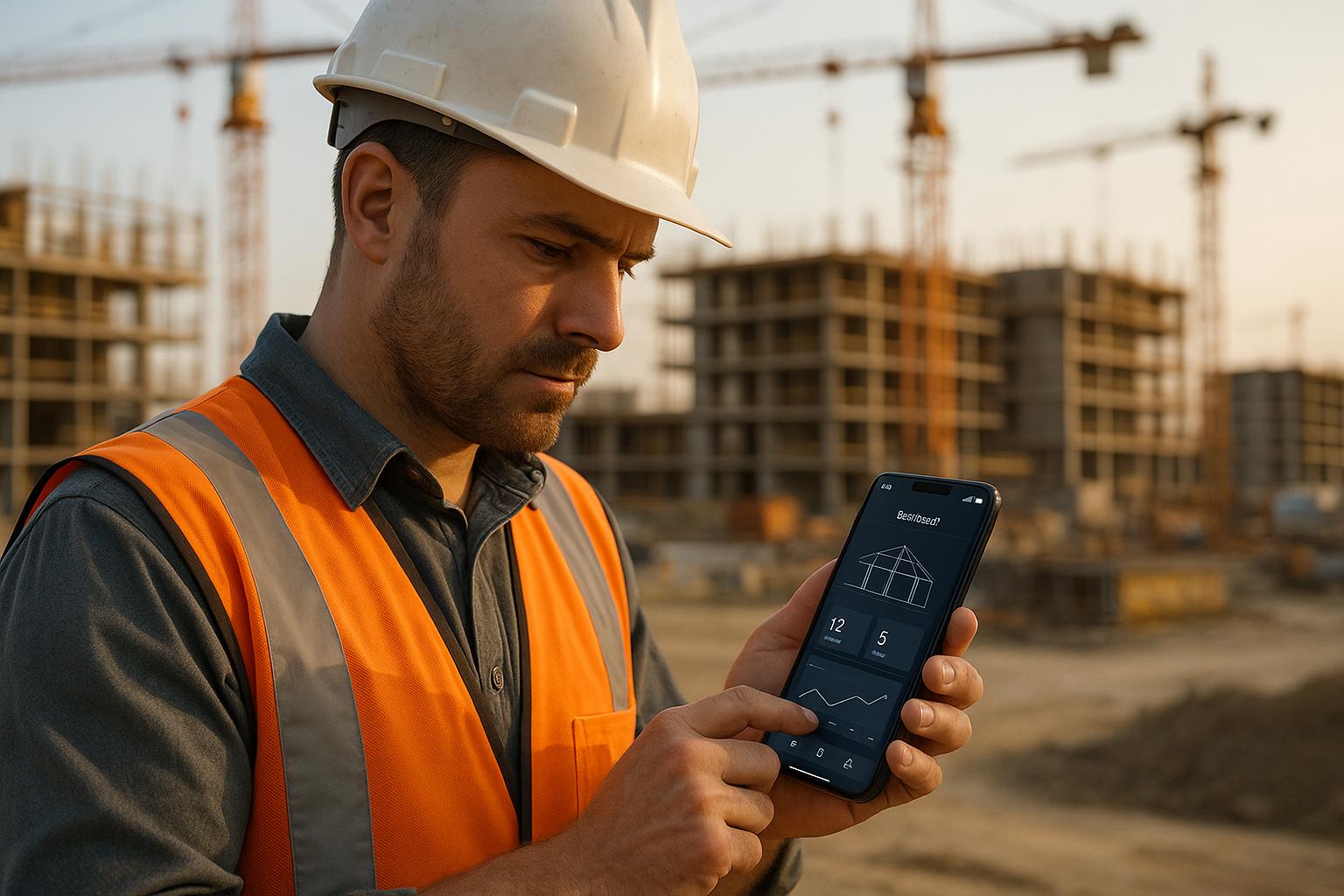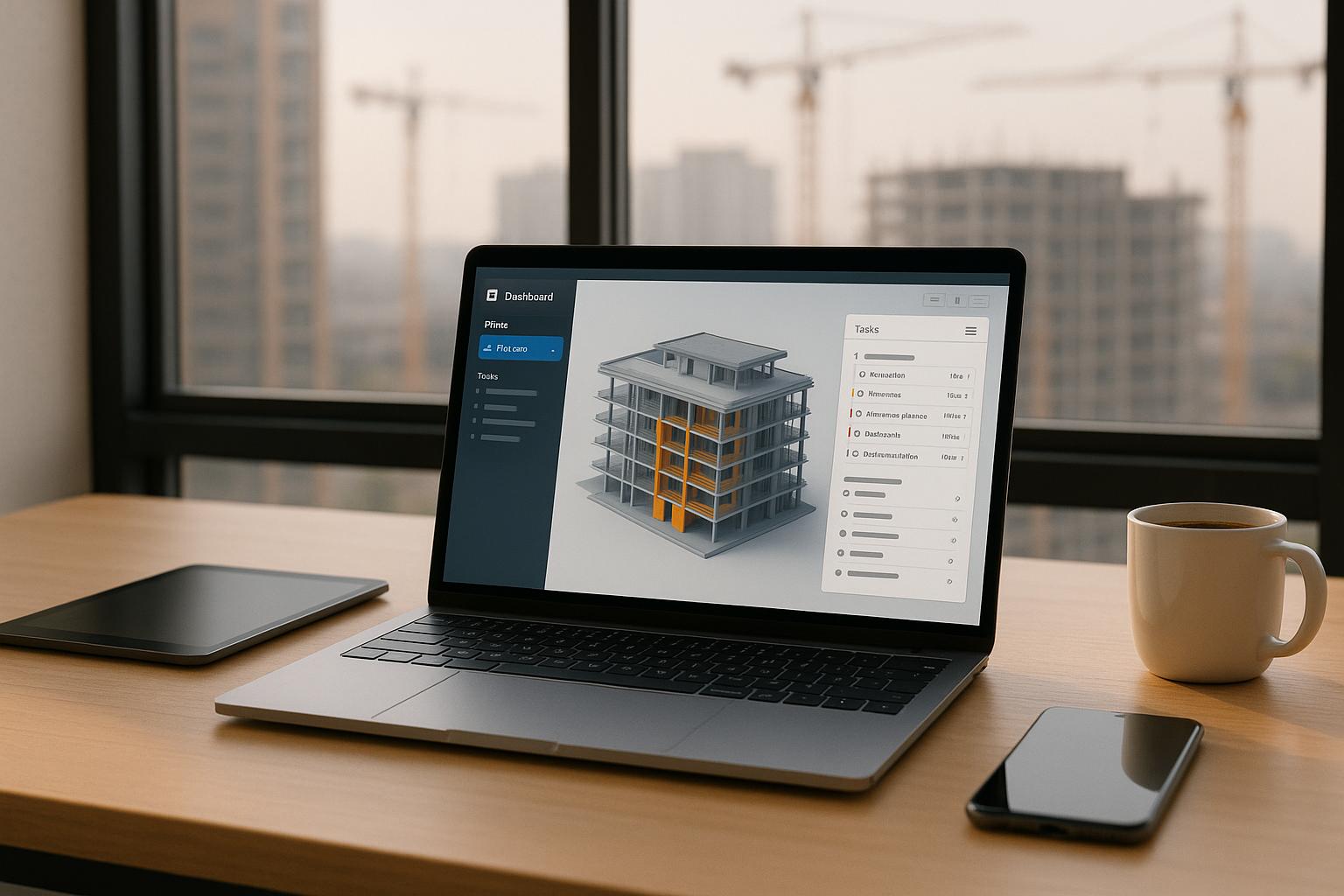Construction Mobile Apps: Native vs Cross-Platform Performance Analysis
Taher Pardawala October 8, 2025
When building mobile apps for the construction industry, the choice between native development and cross-platform development can significantly impact performance, cost, and user experience. Here’s a quick breakdown:
- Native Development: Offers faster performance, better offline functionality, and seamless integration with hardware like GPS and cameras. It’s ideal for apps handling complex tasks like real-time updates or 3D modeling but requires higher upfront investment and longer development time.
- Cross-Platform Development: Speeds up deployment and reduces costs with a single codebase for multiple platforms. Best suited for simpler apps but may struggle with advanced hardware integration and offline reliability.
Key Takeaway: Choose native for performance-heavy, hardware-integrated apps. Opt for cross-platform when budget and speed are priorities, especially for simpler tools.
Quick Comparison
| Criteria | Native Development | Cross-Platform Development |
|---|---|---|
| Performance | Faster and more reliable | Slower for complex tasks |
| Offline Functionality | Strong, seamless access to local storage | Framework-dependent, less reliable |
| Hardware Integration | Full access to device features | Limited, requires extra effort |
| Development Cost | Higher upfront investment | Lower initial costs |
| Time to Market | Longer development time | Faster deployment |
For construction apps, native development is better for complex, data-heavy workflows, while cross-platform works well for simpler MVPs or testing ideas.
Native vs. Cross Platform Apps: A Complete Breakdown
1. Native Development Performance
Native development stands out for its unmatched speed and reliability, thanks to platform-specific languages and APIs. For construction teams relying on apps to instantly update blueprints or track equipment, native development delivers the performance needed for demanding workflows. Let’s dive into the specific advantages that make it so effective.
Performance Speed is a key strength of native development. By being tailored to each platform, native apps can fully utilize the device’s processing power, ensuring faster loading times and smoother interactions. This is especially critical for construction apps that manage large CAD files or process real-time sensor data from job sites. Since native apps run directly on the device’s operating system without extra interpretation layers, they’re ideal for data-intensive workflows.
Scalability and Hardware Integration are also major advantages. Native apps have full access to device features, enabling seamless integration with industry-specific tools like Building Information Modeling (BIM) software and project management systems. For example, they can use GPS for precise site mapping, cameras for documenting progress, or augmented reality for on-site visualization. Whether it’s leveraging the GPU for 3D model rendering or tapping into location services for surveys, native apps make the most of the device’s hardware.
Stability is another crucial benefit, especially in construction environments where app reliability is non-negotiable. Native apps tend to have fewer bugs and receive frequent SDK updates, which translates to consistent improvements. This stability is vital for workers using tablets outdoors, where apps must perform seamlessly – even with gloves on. By following platform-specific design guidelines, native apps offer intuitive interfaces that make accessing project information quick and easy.
Cost-Efficiency and Development Timelines may initially seem like a drawback, as creating separate iOS and Android apps requires more time and investment. However, the long-term benefits – such as better stability, lower maintenance, and smoother adoption of new platform features – often outweigh these upfront costs, particularly for construction apps.
"While cross-platform mobile development is ideal for getting the app to market faster, native apps provide superior security, stability, and scalability." – CircleCI [1]
Security advantages are particularly relevant for construction apps handling sensitive project data or integrating with expensive equipment systems. Native development leverages platform-specific security features to safeguard data and ensure safe connections with industry tools and databases. These technical strengths allow construction teams to efficiently manage tasks like real-time sensor data processing and on-site documentation [1][2].
2. Cross-Platform Development Performance
Cross-platform development relies on creating a single codebase that works across multiple platforms. While this approach can speed up app deployment – an appealing prospect for construction companies – it does come with performance considerations that teams need to weigh carefully.
Performance Speed
One of the challenges with cross-platform frameworks is the added abstraction layer, which can slow responsiveness, especially when handling tasks like processing real-time IoT data or rendering complex 3D models. For instance, frameworks such as React Native and Flutter introduce an interpretive step before execution, which can result in noticeable lag, particularly when managing large datasets like survey information.
That said, cross-platform tools have made strides in improving performance. Flutter, for example, compiles directly to native ARM code, reducing some of the performance penalties. Similarly, React Native uses native components for UI rendering. For many construction-related tasks – such as time tracking, basic project management, or photo documentation – the difference in speed compared to native apps is often minimal. However, when workflows demand high-performance hardware integration, these frameworks may show their limitations.
Scalability and Hardware Integration
Scalability and seamless hardware integration are areas where cross-platform solutions often face hurdles. While these frameworks can handle standard features, integrating specialized construction tools – like laser measuring devices, thermal imaging cameras, or proprietary BIM software – can require custom plugins or native code. This extra development effort offsets the convenience of a single codebase.
For example, achieving precise GPS accuracy for surveying, fully utilizing high-resolution cameras for site documentation, or implementing augmented reality for visualization often demands platform-specific coding. This additional work diminishes some of the efficiency gained through cross-platform development and can make scalability more complex in construction-focused applications.
User Experience Delivery
Consistency in user experience is another potential drawback of cross-platform apps. Workers using different devices may encounter variations in gestures, navigation, or visual elements, which can feel less intuitive compared to native apps. These inconsistencies are particularly problematic in construction environments, where users often wear gloves or work in bright sunlight, making it harder to interact with devices.
Native apps, on the other hand, typically align more closely with platform-specific design guidelines, offering smoother navigation and better accessibility. This can make a significant difference when users need quick access to critical project details under challenging conditions.
Cost-Efficiency and Development Timelines
One of the biggest advantages of cross-platform development is its potential to save both time and money. A single development team can manage one codebase, reducing upfront costs and accelerating the time it takes to launch an app. This allows construction companies to test ideas – like digital punch lists, equipment tracking, or safety checklists – across different platforms quickly, gathering feedback and refining features before committing to more resource-intensive native development.
However, as apps grow more complex and require deeper integration with industry-specific tools, the initial cost savings may erode. Cross-platform solutions often need additional native development to support advanced features. Furthermore, when platforms release updates, maintaining the app can become more labor-intensive, as the cross-platform codebase may require adjustments even if the app’s core functionality remains unchanged.
sbb-itb-51b9a02
Advantages and Disadvantages
When deciding between native and cross-platform development for construction mobile apps, it’s important to weigh the pros and cons – particularly when it comes to offline functionality, which is often a must-have on construction sites.
| Offline Capability | Native Development | Cross-Platform Development |
|---|---|---|
| Reliability in Disconnected Environments | Offers robust offline functionality with seamless access to local storage and databases, even in airplane mode[3]. | Supports offline features, but the ease and efficiency of implementation can depend heavily on the framework used[3]. |
Here’s a closer look at how each approach handles offline operations in construction settings.
Native Development Strengths
Native apps are a strong choice for construction environments that rely on offline access. They can directly interact with local storage and databases, ensuring that users can retrieve and work with project data even without an internet connection[3].
Cross-Platform Development Considerations
Cross-platform apps simplify development with a single codebase for multiple platforms. However, their offline functionality can vary depending on the framework used. Developers may need to invest extra time and resources to configure reliable offline features, potentially delaying deployment and affecting the delicate balance between performance and cost for construction apps[3].
Key Consideration
Offline functionality is non-negotiable for construction mobile apps, especially for job site use where connectivity is often unreliable. While native development consistently delivers strong offline performance, cross-platform solutions require thorough testing and additional effort to ensure they meet the demands of construction workflows when internet access is limited. These trade-offs are critical when designing an MVP tailored to construction site needs.
Conclusion
Deciding between native and cross-platform development for construction mobile apps hinges on your project’s unique requirements, budget, and long-term goals. Each approach has its strengths, and understanding these can play a crucial role in shaping the success of your minimum viable product (MVP) in the demanding construction industry.
If your app demands top-notch performance, seamless offline capabilities, or deep integration with device-specific features like GPS, cameras, or sensors, native development is the way to go. This method is ideal for apps handling complex tasks such as 3D modeling, real-time data processing, or safety-critical operations where even slight delays can disrupt workflows.
On the other hand, cross-platform development shines when speed and cost-efficiency are priorities. For startups working with limited budgets and tight timelines, the ability to use a single codebase across multiple platforms can save both time and money. However, this approach may face challenges if your app eventually requires heavy platform-specific customizations or runs into performance issues that demand native solutions.
For construction MVPs, here’s a practical rule of thumb: opt for native development if your app is data-heavy, relies on offline functionality, or needs advanced hardware integration. Choose cross-platform for simpler tools where rapid deployment is key.
Keep in mind, this decision doesn’t have to be final. Many successful construction tech companies start with cross-platform MVPs to test their market fit and later transition critical features to native as they grow. The key is aligning your development strategy with your business goals while keeping scalability in mind.
As construction workflows grow more sophisticated and require advanced features, you can revisit and adapt your approach. The right choice will not only meet your current needs but also prepare your app for future growth.
FAQs
What should I consider when choosing between native and cross-platform development for a construction mobile app?
When choosing between native and cross-platform development for a construction mobile app, it’s essential to weigh factors like performance requirements, budget constraints, and your project timeline.
Native apps are known for delivering top-notch performance and a seamless user experience. They’re especially well-suited for handling complex construction workflows, such as offline capabilities and real-time updates. If your app needs to integrate smoothly with specialized industry tools or is expected to scale over time, native development might be the better route.
On the flip side, cross-platform development offers a faster, more budget-friendly option. It’s ideal for simpler apps or when you need to launch across multiple devices without delay. This approach can save time and resources while still meeting basic functionality needs.
In the end, the best choice depends on your app’s specific goals, whether you’re building an MVP or planning for long-term growth.
Why is offline functionality important for construction apps, and how does it differ between native and cross-platform development?
Offline functionality is a game-changer for construction apps, especially since job sites often face unreliable or no internet access. With offline capabilities, workers can still access critical project data, safety guidelines, and updates. This helps prevent delays, keeps operations running smoothly, and enhances both productivity and safety on-site.
Native apps tend to shine in offline scenarios. They tap into device-specific features and store data locally, ensuring smoother performance even without an internet connection. Cross-platform apps, while capable of supporting offline features, can sometimes struggle with more complex synchronization tasks, particularly in demanding construction environments.
For workflows that depend heavily on real-time updates and offline access, selecting the right app approach is key to maintaining efficiency and a seamless user experience.
Can a construction app built as a cross-platform MVP be converted to native development later? What are the pros and cons of doing so?
Yes, it’s entirely possible for a construction app initially developed as a cross-platform MVP to later shift to native development. However, this shift usually means rewriting the entire codebase, which can be a time-consuming and resource-intensive process.
Switching to native development offers some clear advantages. It can significantly boost performance, provide a smoother user experience, and allow better integration with device-specific features. These are critical for construction apps, especially those that need offline functionality, real-time updates, and seamless integration with various tools.
That said, there are also hurdles to consider. Native development often comes with higher costs, potential delays, and the need to redesign the app’s architecture. This makes the decision to transition a thoughtful, strategic choice – typically driven by long-term goals like improving scalability and optimizing performance.








Leave a Reply